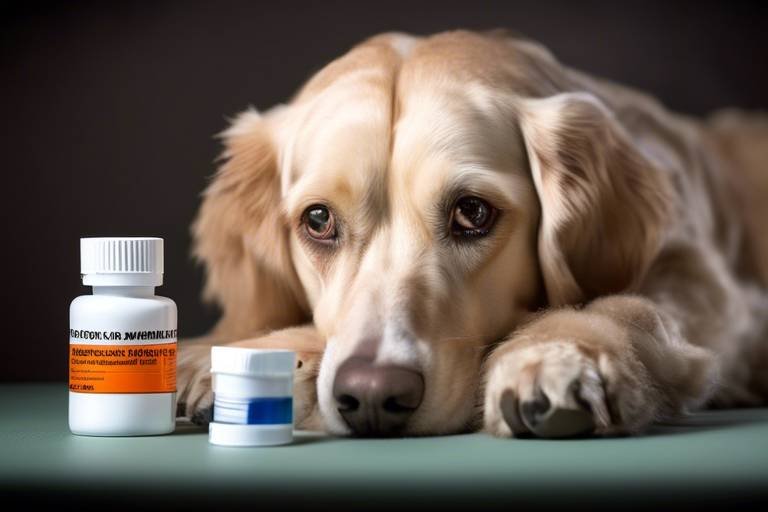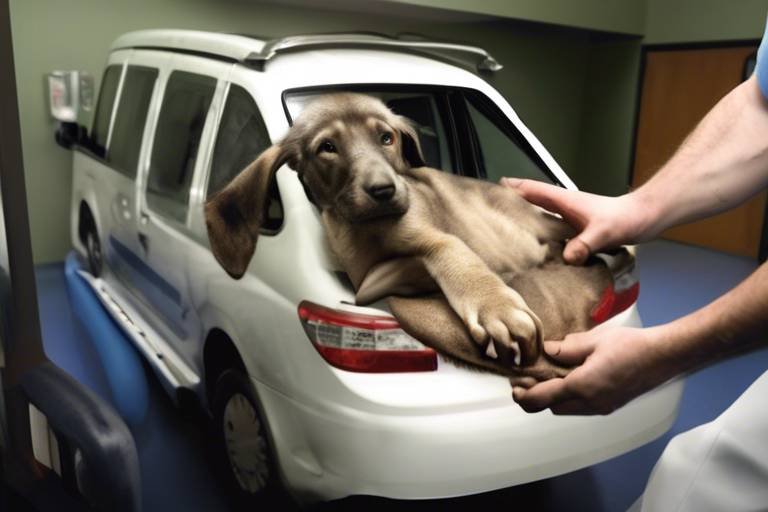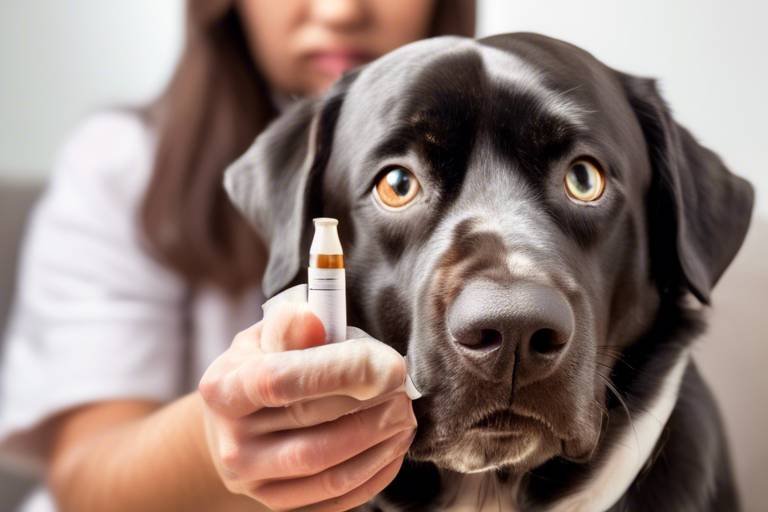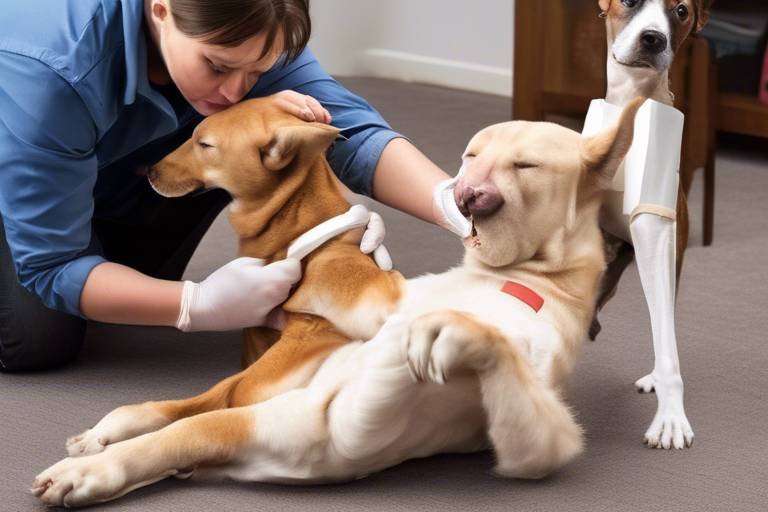What to Do If Your Pet Experiences an Anaphylactic Reaction
As a pet owner, there’s nothing more alarming than witnessing your furry friend in distress. Anaphylactic reactions can occur suddenly and without warning, often triggered by allergens like certain foods, insect stings, or medications. It's essential to be prepared and know how to respond effectively. In this article, we’ll explore how to recognize the signs of anaphylaxis, the immediate steps you should take, and preventive measures to keep your pet safe.
Understanding the signs of anaphylaxis in pets is crucial for timely intervention. Common symptoms include swelling, particularly around the face and neck, difficulty breathing, and the appearance of hives or welts on the skin. These symptoms can escalate rapidly, leading to a life-threatening situation. Here are some key signs to watch for:
- Swelling of the face, lips, or tongue
- Rapid breathing or wheezing
- Vomiting or diarrhea
- Weakness or lethargy
- Seizures
If you notice any of these symptoms, it’s vital to act quickly. The faster you respond, the better the chances of a positive outcome.
Knowing the first aid steps to take when your pet shows signs of anaphylaxis can save their life. First and foremost, stay calm. Your pet can sense your anxiety, which may only worsen their stress. Immediately call your veterinarian or an emergency animal clinic while keeping an eye on your pet's condition. If you have been trained, you may need to administer emergency treatments such as epinephrine.
Epinephrine is often the first-line treatment for severe allergic reactions. If your veterinarian has prescribed an epinephrine auto-injector for your pet, knowing how to use it is crucial. Here’s a quick guide:
| Dosage | Timing | Administration Method |
|---|---|---|
| As directed by your vet | As soon as symptoms appear | Inject into the thigh muscle |
It's fundamental to monitor the timing of the injection closely, as the effects of epinephrine can wear off quickly. If symptoms persist, a second dose may be necessary, but consult your vet for guidance.
It's essential to know when to use epinephrine for your pet. If your pet exhibits severe symptoms such as difficulty breathing or extreme swelling, administering epinephrine quickly can be a lifesaver. However, if symptoms are mild, it may not be necessary. Always err on the side of caution and consult your veterinarian when in doubt.
While epinephrine can be life-saving, it may also cause side effects like increased heart rate, restlessness, or tremors. Familiarize yourself with these potential reactions to ensure you monitor your pet closely after administration. If you notice concerning side effects, contact your veterinarian immediately.
After administering first aid, transporting your pet to the veterinarian is vital. Here are some best practices for safely moving your pet during an emergency:
- Keep your pet calm and secure in a carrier or on a leash.
- Avoid sudden movements that could stress them further.
- Drive carefully and avoid sharp turns or abrupt stops.
Every second counts, so make sure to get to the vet as quickly and safely as possible.
Taking preventive steps can significantly reduce the risk of anaphylactic reactions in pets. Start by identifying potential allergens in your pet's environment. This includes avoiding exposure to known triggers and discussing allergy testing options with your veterinarian. Regular check-ups can help you stay ahead of any allergy issues.
Understanding common allergens that affect pets can help you avoid potential triggers. Here are some common culprits:
- Food Allergies: Certain proteins, grains, or additives.
- Environmental Factors: Pollen, dust mites, or mold.
- Insect Bites: Fleas, ticks, and bee stings.
By keeping an eye on your pet's environment and diet, you can help prevent allergic reactions from occurring.
Regular consultations with your veterinarian can help manage your pet's allergies effectively. Discussing symptoms, triggers, and treatment options can lead to a tailored plan for your pet's health. Your vet may suggest dietary changes, medications, or even immunotherapy based on your pet's specific needs.
1. How can I tell if my pet is having an allergic reaction?
Look for symptoms like swelling, difficulty breathing, or hives. If you notice any of these signs, act immediately.
2. Is it safe to administer epinephrine at home?
If prescribed by your vet and you are trained, it can be safe. Always follow your vet's instructions.
3. What should I do if my pet has a mild allergic reaction?
Monitor your pet closely and consult your veterinarian for advice on next steps.
4. Can I prevent allergies in my pet?
While you can’t prevent all allergies, identifying and avoiding known triggers can significantly reduce the risk.

Recognizing Anaphylactic Symptoms
When it comes to our beloved pets, their health and safety are always a top priority. One of the most serious health emergencies a pet can face is an anaphylactic reaction. But how can you tell if your furry friend is experiencing this life-threatening condition? Understanding the signs is crucial for timely intervention. Anaphylaxis can happen suddenly, and recognizing the symptoms can mean the difference between life and death.
Common symptoms of anaphylaxis in pets can vary, but some of the most alarming signs include:
- Swelling: Look for swelling around the face, particularly around the eyes and muzzle. This can happen very quickly and may be accompanied by redness.
- Difficulty Breathing: If your pet is panting, wheezing, or showing signs of distress while breathing, this is a serious indicator that they may be in trouble.
- Hives: Raised, itchy welts on the skin can appear, often resembling a rash. These hives can be quite uncomfortable for your pet.
- Vomiting or Diarrhea: Gastrointestinal distress can occur, leading to vomiting or severe diarrhea, which can further exacerbate dehydration.
- Weakness or Collapse: In severe cases, your pet may become lethargic or even collapse, indicating that immediate action is required.
It’s important to note that these symptoms can escalate rapidly. What starts as mild swelling can quickly lead to severe respiratory distress. If you notice any of these signs, don’t hesitate—seek help immediately. Just like humans, pets can experience a range of allergic reactions, and anaphylaxis is at the extreme end of that spectrum. The faster you act, the better the chances of a positive outcome for your pet.
Additionally, some pets might show more subtle signs that can easily be overlooked. Changes in behavior, such as increased agitation or restlessness, can also be a signal that something is wrong. Always trust your instincts; if you feel something is off with your pet, it’s better to err on the side of caution and consult with a veterinarian.
In summary, recognizing the symptoms of anaphylaxis in your pet is vital. Be vigilant and observant, as knowing what to look for can help you act swiftly in an emergency. Remember, your pet relies on you to be their voice and protector. Stay informed and be prepared to take action!

Immediate First Aid Steps
When your beloved pet shows signs of an anaphylactic reaction, the first thing you need to do is stay calm. I know, it’s easier said than done! But panicking won’t help your furry friend. Instead, take a deep breath and assess the situation. Remember, time is of the essence, and your response can make a world of difference. Start by observing their symptoms closely. Common signs include swelling, difficulty breathing, and hives, which can escalate quickly. If you notice any of these, it's time to spring into action!
Your first step should be to call your veterinarian immediately. Explain the situation clearly and provide as much detail as possible about your pet's symptoms. This will help them prepare for your arrival and give you specific instructions on what to do next. While waiting for further guidance, if you’ve been trained in administering emergency treatments, you can prepare to take action. Just a quick heads up: if you haven’t received proper training, it’s best to avoid any complicated procedures that could worsen the situation.
One of the most critical interventions you can perform is administering epinephrine, especially if your pet is experiencing severe symptoms like difficulty breathing or swelling of the throat. If you have an epinephrine auto-injector, make sure you know how to use it properly. Here’s a quick breakdown of the steps:
- Remove the auto-injector from its case.
- Hold the injector firmly and remove the safety cap.
- Press the injector against your pet’s thigh and push down to release the medication.
- Hold it in place for a few seconds to ensure the medication is delivered.
After administering epinephrine, keep a close watch on your pet. Monitor their breathing and overall condition. If they seem to improve, that’s great, but don’t let your guard down just yet! You still need to get them to the vet as soon as possible. If symptoms worsen or new ones develop, such as excessive drooling or vomiting, be ready to act swiftly.
Once you’ve stabilized your pet, it’s essential to transport them to the veterinarian safely. If they are conscious and alert, try to keep them calm during the journey. Use a carrier or a blanket to support them, especially if they seem weak or disoriented. If your pet is unconscious or having severe trouble breathing, handle them gently and securely to avoid causing further distress.
In summary, immediate first aid for anaphylactic reactions in pets is all about quick recognition and action. From staying calm to administering epinephrine and safely transporting your pet to the vet, every step you take can significantly impact their recovery. Remember, knowledge is power, and being prepared can mean the difference between life and death for your furry friend.
1. What are the signs that my pet is having an anaphylactic reaction?
Common signs include swelling, difficulty breathing, hives, vomiting, and lethargy. If you notice any of these symptoms, act quickly!
2. How do I know if I should administer epinephrine?
If your pet is showing severe symptoms such as difficulty breathing or swelling, it’s crucial to administer epinephrine. Always consult with your veterinarian for specific guidance.
3. What should I do if my pet has a known allergy?
Identify the allergens and work closely with your veterinarian to create a management plan that includes avoiding triggers and monitoring for any signs of allergic reactions.
Administering Epinephrine
When your beloved pet is experiencing an anaphylactic reaction, time is of the essence. Administering epinephrine can be a lifesaving measure, but it’s crucial to know how to do it correctly. First off, make sure you have a veterinary-approved epinephrine auto-injector on hand. This device is designed for emergency situations and can be a game changer when your pet's life is on the line.
Before you administer the medication, it's essential to assess the severity of your pet's symptoms. Look for signs such as severe swelling, difficulty breathing, or rapid heart rate. If your pet is exhibiting these symptoms, it’s time to act. The typical dosage for dogs and cats can vary based on their weight, so always refer to your veterinarian’s guidelines or the instructions that come with the auto-injector.
Here’s a quick guide on how to administer epinephrine:
- Ensure you are calm and collected; your pet can sense your anxiety.
- Locate the injection site, which is usually the outer thigh muscle.
- Inject the epinephrine at a 90-degree angle to the skin.
- Press the device firmly until you hear a click, indicating that the injection has been delivered.
- Keep the injector in place for a few seconds to ensure the medication is absorbed.
After administering epinephrine, closely monitor your pet for any changes. While it can provide immediate relief, the effects of epinephrine are temporary, and your pet may still need further medical attention. It's vital to transport your pet to the veterinarian as soon as possible, even if they seem to improve. Remember, epinephrine is just the first step in a longer treatment process.
It’s also worth mentioning that the timing of the injection is critical. If you suspect your pet is having an anaphylactic reaction, don’t wait to see if their symptoms improve. Administer the epinephrine as soon as possible. The sooner you act, the better the chances of a positive outcome.
Finally, it’s important to familiarize yourself with the potential side effects of epinephrine. While it can be lifesaving, it can also lead to increased heart rate, anxiety, and even tremors in some pets. Monitoring your pet after administration is crucial to ensure they are stable and not experiencing adverse reactions.
Q: How long does it take for epinephrine to work?
A: Typically, you can expect to see improvements within minutes, but this can vary based on the severity of the reaction.
Q: Can I give my pet epinephrine if I’m unsure they are having an anaphylactic reaction?
A: If you suspect anaphylaxis, it’s better to administer the epinephrine than to wait. It’s a safe option in emergencies.
Q: How often can I administer epinephrine?
A: You can administer a second dose if symptoms do not improve after 5-15 minutes, but always consult your veterinarian for specific guidance.
Q: What should I do if I accidentally give too much epinephrine?
A: Seek immediate veterinary care. Overdosing can lead to serious complications.
When to Use Epinephrine
Knowing when to use epinephrine for your pet is crucial, as timing can be the difference between life and death. Anaphylaxis can escalate quickly, and recognizing the severity of your pet's symptoms is key to making this critical decision. If your pet exhibits any of the following symptoms, it may be time to act:
- Severe swelling of the face, lips, or throat
- Difficulty breathing, which may include wheezing or gasping for air
- Rapid heart rate or signs of shock, such as weakness or lethargy
- Hives or extensive skin reactions
- Vomiting or diarrhea that appears suddenly
In these situations, it’s essential to act swiftly. Epinephrine should be administered as soon as possible if you suspect your pet is experiencing anaphylaxis. This medication works by constricting blood vessels and opening airways, thus reversing the severe symptoms of an allergic reaction.
However, it's important to note that epinephrine is not a cure-all. After administration, your pet still requires immediate veterinary care. The effects of epinephrine can be temporary, and additional treatment may be necessary to stabilize your pet's condition. Always keep a close eye on your pet after administering this medication, as symptoms can recur.
Remember, knowing your pet's normal health behavior is vital. If you notice any unusual changes, it’s better to err on the side of caution and consult with your veterinarian. Understanding your pet's triggers and having a plan in place can significantly reduce the risks associated with allergic reactions.
Here are some common questions pet owners have regarding the use of epinephrine and anaphylactic reactions:
- How quickly does epinephrine work? Epinephrine usually takes effect within minutes, but the duration may vary depending on the severity of the reaction.
- Can I give my pet epinephrine if I'm unsure? If you suspect anaphylaxis, it’s better to administer it than to wait. Always follow up with your veterinarian.
- Are there any risks associated with epinephrine? Yes, while it can be life-saving, it may cause side effects such as increased heart rate or anxiety. Monitor your pet closely after administration.
Side Effects of Epinephrine
While epinephrine is a critical medication that can be life-saving during an anaphylactic reaction in pets, it's essential to be aware of its potential side effects. Just like any medication, epinephrine can cause reactions that may vary in severity among different animals. Some pets might experience mild effects, while others could face more serious complications.
Common side effects of epinephrine may include:
- Increased heart rate: This is one of the most common effects and can be alarming if you're not prepared. Your pet's heart may race as the medication stimulates their cardiovascular system.
- Restlessness or agitation: After administration, some pets may appear more anxious or hyperactive than usual. This reaction is often temporary but can be distressing for both you and your pet.
- Tremors: Muscle tremors or shaking can occur as a result of the increased adrenaline in their system.
- Vomiting: Some pets might experience nausea, leading to vomiting shortly after receiving epinephrine.
- High blood pressure: Epinephrine can cause a spike in blood pressure, which may require monitoring, especially in pets with pre-existing health conditions.
It's important to monitor your pet closely after administering epinephrine. If you notice any severe reactions or if the side effects persist longer than expected, contacting your veterinarian immediately is crucial. They can provide guidance on how to manage these side effects and determine if further treatment is necessary. Remember, while the benefits of epinephrine often outweigh the risks, being informed and prepared is key to ensuring your pet's safety.
In conclusion, understanding the potential side effects of epinephrine empowers pet owners to act confidently during emergencies. Always consult with your veterinarian about your pet's specific health needs and any concerns you may have regarding the use of epinephrine or other medications.
- What should I do if my pet experiences side effects after receiving epinephrine? Contact your veterinarian immediately for advice and possible treatment options.
- How can I tell if my pet is having an allergic reaction? Look for symptoms like swelling, hives, difficulty breathing, or vomiting. If you notice these, seek veterinary help right away.
- Is epinephrine safe for all pets? While epinephrine is generally safe for most pets, always consult your veterinarian for specific recommendations based on your pet's health history.
- Can I administer epinephrine at home? If you have been trained and your veterinarian has prescribed it, you may administer it at home. However, always follow their instructions carefully.
Transporting Your Pet to the Vet
When your furry friend experiences an anaphylactic reaction, every second counts, and knowing how to transport them safely to the veterinarian can make all the difference. First and foremost, staying calm is crucial—not just for you, but for your pet, who can sense your anxiety. If your pet is panicking, they may struggle more, making it harder to get them to the vet. So, take a deep breath and focus on the task at hand.
Before you even think about moving your pet, assess their condition. If they’re having trouble breathing or are severely distressed, you may need to take extra precautions. Ideally, you should have a pet carrier or a sturdy blanket ready to gently lift them. If they’re small enough, a carrier can provide a sense of security, while larger pets may need to be wrapped securely in a blanket to avoid any sudden movements that could worsen their condition.
Here are some important tips to consider while transporting your pet:
- Keep them comfortable: If your pet is conscious, try to keep them calm by speaking softly and reassuringly. If they are unconscious, be gentle and careful when lifting them.
- Secure them properly: If using a car, ensure your pet is secured in a carrier or restrained with a seatbelt. This is vital for both their safety and yours.
- Drive safely: Avoid sudden stops and sharp turns. Drive as smoothly as possible to prevent any additional stress or injury to your pet.
While en route to the vet, keep an eye on your pet's symptoms. If you notice any changes—like worsening breathing or loss of consciousness—be prepared to take immediate action. If you have administered epinephrine, note the time it was given, as this information will be crucial for the vet. When you arrive at the veterinary clinic, communicate clearly about what has happened, including any medications administered and the timeline of events.
In emergency situations, every detail matters, so having a plan in place can save precious time. Consider having a pet first-aid kit in your home and car, and familiarize yourself with the quickest route to your vet. Knowing what to do in advance can help you stay focused and act quickly when it matters most.
Q: What should I do if my pet is allergic to something?
A: Consult your veterinarian to identify the allergen and discuss potential treatments or preventive measures.
Q: How can I tell if my pet is having an allergic reaction?
A: Look for symptoms such as swelling, hives, difficulty breathing, or excessive scratching. If you notice these signs, seek veterinary help immediately.
Q: Is epinephrine safe for pets?
A: Yes, when administered correctly, epinephrine can be life-saving for pets experiencing severe allergic reactions. Always consult your veterinarian for proper dosage and application.
Q: How can I prevent my pet from having an anaphylactic reaction?
A: Identifying and avoiding allergens is key. Regular check-ups with your veterinarian can help manage and monitor your pet's allergies effectively.

Preventive Measures for Allergies
Taking proactive steps to safeguard your pet from anaphylactic reactions is not just a good idea; it’s essential for their health and happiness. Just like we humans try to avoid allergens, our furry friends need similar attention to detail. The first step in prevention is identifying potential allergens. This can range from certain foods to environmental factors that might trigger a reaction. For instance, did you know that some pets can have severe reactions to common ingredients like chicken or beef? It’s crucial to be aware of what goes into their diet.
Another vital aspect of prevention is avoiding exposure. Once you know what your pet is allergic to, it’s time to create a safe haven. If your pet is allergic to pollen, limiting their outdoor time during high pollen seasons can make a significant difference. Similarly, if they react to certain foods, always read labels and be cautious about what treats you offer. In fact, keeping a detailed list of known allergens can help everyone in the household stay informed and vigilant.
Additionally, discussing allergy testing options with your veterinarian can provide valuable insights into your pet's specific triggers. Veterinarians can conduct tests to pinpoint allergens, which can lead to a tailored management plan. This plan may include dietary changes, medication, or even immunotherapy to desensitize your pet to certain allergens. Regular check-ups are also essential; they allow your vet to monitor your pet's health and adjust their treatment plan as needed.
It's important to remember that prevention is always better than cure. By being proactive and informed, you can significantly reduce the risk of anaphylactic reactions in your beloved pet. Just as we prepare for unexpected events in our lives, preparing for potential allergies can save your pet from distress and keep them happy and healthy.
- What are the common signs of allergies in pets? Look for symptoms like itching, swelling, hives, and difficulty breathing.
- How can I identify what my pet is allergic to? Consulting with your veterinarian and possibly conducting allergy tests can help identify specific allergens.
- Is there a way to prevent allergies altogether? While you can’t prevent allergies entirely, you can take steps to minimize exposure to known allergens.
- What should I do if my pet has an allergic reaction? Stay calm, administer first aid if trained, and get your pet to a veterinarian as quickly as possible.
Identifying Common Allergens
When it comes to our beloved pets, understanding what triggers their allergic reactions is crucial for their health and well-being. Just like humans, pets can have a variety of allergens that cause them discomfort or even life-threatening reactions. By identifying these common allergens, you can take proactive measures to safeguard your furry friend.
Common allergens can be broadly categorized into three main groups: food, environmental factors, and insect bites. Each of these categories can pose serious risks to your pet, and being aware of them is the first step in prevention. For instance, food allergies often manifest as skin irritations or gastrointestinal upset. Ingredients like beef, chicken, dairy, and wheat are frequent culprits. If you notice your pet scratching excessively or having digestive issues after eating certain foods, it might be time to consult your veterinarian.
Environmental allergens are another significant concern. Pollen, dust mites, mold, and certain grasses can trigger allergic reactions in pets, leading to symptoms such as sneezing, itching, and even respiratory issues. It's essential to monitor your pet's behavior and environment closely. For example, if your pet seems to have seasonal allergies, consider keeping them indoors during high pollen counts or using air purifiers in your home.
Insect bites, particularly from fleas, ticks, and mosquitoes, can also lead to severe allergic reactions in pets. Flea allergy dermatitis is a common condition where pets become extremely sensitive to flea saliva, causing intense itching and skin infections. Regularly treating your pet for fleas and ticks, along with maintaining a clean living environment, can significantly reduce the risk of these reactions.
To further assist you in identifying potential allergens, here’s a quick reference table:
| Allergen Type | Common Sources | Symptoms |
|---|---|---|
| Food | Beef, chicken, dairy, wheat | Itching, digestive upset |
| Environmental | Pollen, dust mites, mold | Sneezing, itching, respiratory issues |
| Insect Bites | Fleas, ticks, mosquitoes | Intense itching, skin infections |
By keeping tabs on these common allergens and their sources, you can help your pet lead a more comfortable and healthier life. If you suspect your pet has allergies, don’t hesitate to reach out to your veterinarian for a thorough evaluation and tailored treatment plan.
- What are the signs that my pet may have allergies? Look for symptoms like excessive scratching, sneezing, or gastrointestinal issues. If you notice these signs, consult your vet.
- Can allergies be treated? Yes, allergies can often be managed through medication, dietary changes, and avoiding known allergens.
- How can I test my pet for allergies? Your veterinarian can perform skin or blood tests to identify specific allergens affecting your pet.
- Are certain breeds more prone to allergies? Yes, some breeds are genetically predisposed to allergies. It's essential to be aware of your pet's breed-specific risks.
Consulting with Your Veterinarian
When it comes to your pet's health, is not just a good idea; it's essential. Regular check-ups can help you stay ahead of potential health issues, including allergies that could lead to anaphylactic reactions. Think of your vet as your pet’s personal health coach, guiding you through the maze of pet care. They have the expertise to help you identify any underlying issues that might contribute to allergic reactions.
During your visits, it's crucial to discuss any changes in your pet's behavior or health. Have they been scratching more than usual? Are they sneezing or experiencing gastrointestinal distress? These symptoms might seem minor but can indicate a bigger problem. By sharing detailed observations with your veterinarian, you can help them make informed decisions about your pet's health.
Additionally, your vet can provide valuable insights into allergy testing. This can include skin tests or blood tests that identify specific allergens affecting your pet. Knowing what your pet is allergic to can empower you to take preventive measures, such as altering their diet or avoiding certain environments. In fact, many pet owners find that keeping a pet health journal is beneficial. It allows you to track any symptoms and reactions over time, making it easier for your vet to spot patterns.
Moreover, don't hesitate to ask questions during your consultations. Here are some examples of questions you might consider:
- What are the most common allergens for pets in our area?
- How can I manage my pet's allergies effectively?
- What treatments are available for severe allergic reactions?
- Are there any specific dietary recommendations to help reduce allergic reactions?
Remember, your veterinarian is there to help you navigate the complexities of pet care. They can offer tailored advice that considers your pet's unique needs and lifestyle. By fostering a good relationship with your veterinarian, you can ensure that your furry friend receives the best possible care. It's all about teamwork—your vet and you, working together to keep your pet healthy and happy.
Q1: How can I tell if my pet is having an allergic reaction?
A: Look for symptoms such as swelling, hives, difficulty breathing, or excessive scratching. If you notice any of these signs, seek veterinary assistance immediately.
Q2: Can I administer medication to my pet without consulting a vet?
A: It's not advisable. Always consult your veterinarian before giving any medication to ensure it's safe and appropriate for your pet's specific situation.
Q3: How often should I take my pet to the vet for allergy check-ups?
A: Regular check-ups are recommended at least once a year, but more frequent visits may be necessary if your pet has known allergies or shows symptoms.
Q4: What should I do if my pet has a severe allergic reaction?
A: Stay calm, administer any prescribed emergency medication like epinephrine if you are trained, and seek immediate veterinary care.
Frequently Asked Questions
- What are the signs of anaphylaxis in pets?
Anaphylaxis can be a scary experience for both pets and their owners. Common signs include swelling of the face or limbs, difficulty breathing, hives, and in some cases, vomiting or diarrhea. If you notice any of these symptoms, it’s crucial to act quickly!
- What should I do if my pet has an anaphylactic reaction?
First and foremost, stay calm. Your pet can sense your anxiety. Immediately call your veterinarian or an emergency animal clinic. If you’re trained, you may need to administer epinephrine if your pet's symptoms are severe. Remember, getting your pet to the vet as soon as possible is vital!
- How do I administer epinephrine to my pet?
Administering epinephrine can be lifesaving, but it’s essential to know how to do it correctly. Typically, it’s injected subcutaneously (under the skin). Dosage will depend on your pet’s size, so consult with your vet beforehand to have a clear plan in case of an emergency.
- When should I use epinephrine for my pet?
Use epinephrine when your pet shows severe symptoms like swelling or trouble breathing. Quick action is crucial since anaphylaxis can escalate rapidly. If you’re unsure, it’s always best to err on the side of caution and consult your vet.
- What are the side effects of epinephrine?
While epinephrine can be a lifesaver, it can also cause side effects such as increased heart rate, nervousness, or tremors. After administering it, keep a close eye on your pet and inform your vet about any reactions.
- How should I transport my pet to the vet after an allergic reaction?
Transporting your pet safely is critical. Use a sturdy carrier or a leash to keep them secure. If they’re unconscious or severely distressed, ensure they’re stable before moving them. Keep the environment calm to reduce their stress levels during transport.
- How can I prevent my pet from having an anaphylactic reaction?
Prevention is key! Start by identifying potential allergens in your pet's environment. This could include certain foods, plants, or insect bites. Regular consultations with your vet can help you develop a tailored plan to keep your furry friend safe.
- What are common allergens for pets?
Common allergens include certain foods (like grains or dairy), pollen, dust mites, and insect stings. Knowing these can help you avoid situations that might trigger an allergic reaction in your pet.
- Should I consult my veterinarian about my pet's allergies?
Absolutely! Regular check-ups are essential for managing your pet's health. Discuss any symptoms or triggers you’ve noticed, and your vet can help create a comprehensive plan to keep your pet happy and healthy.



















